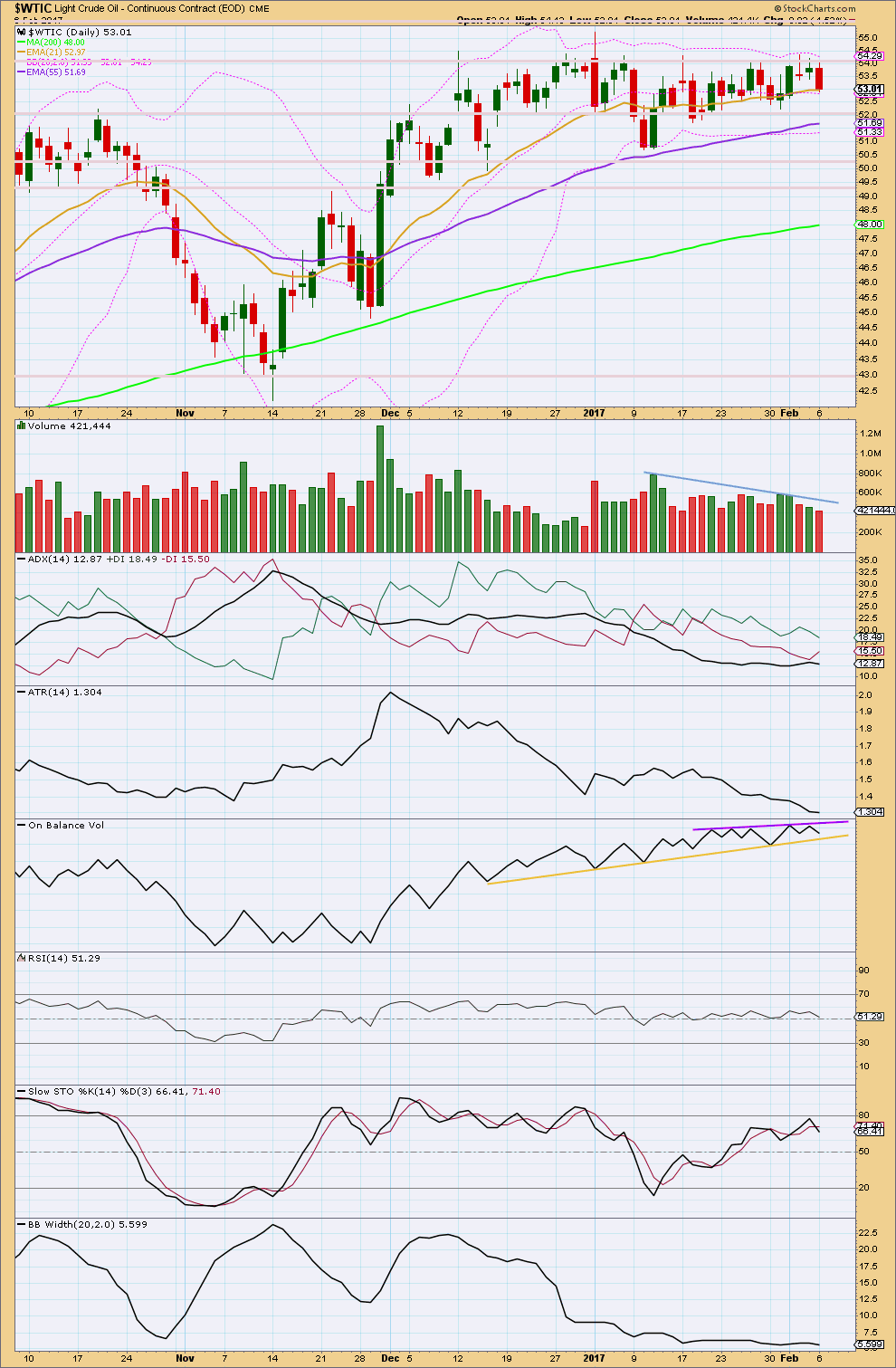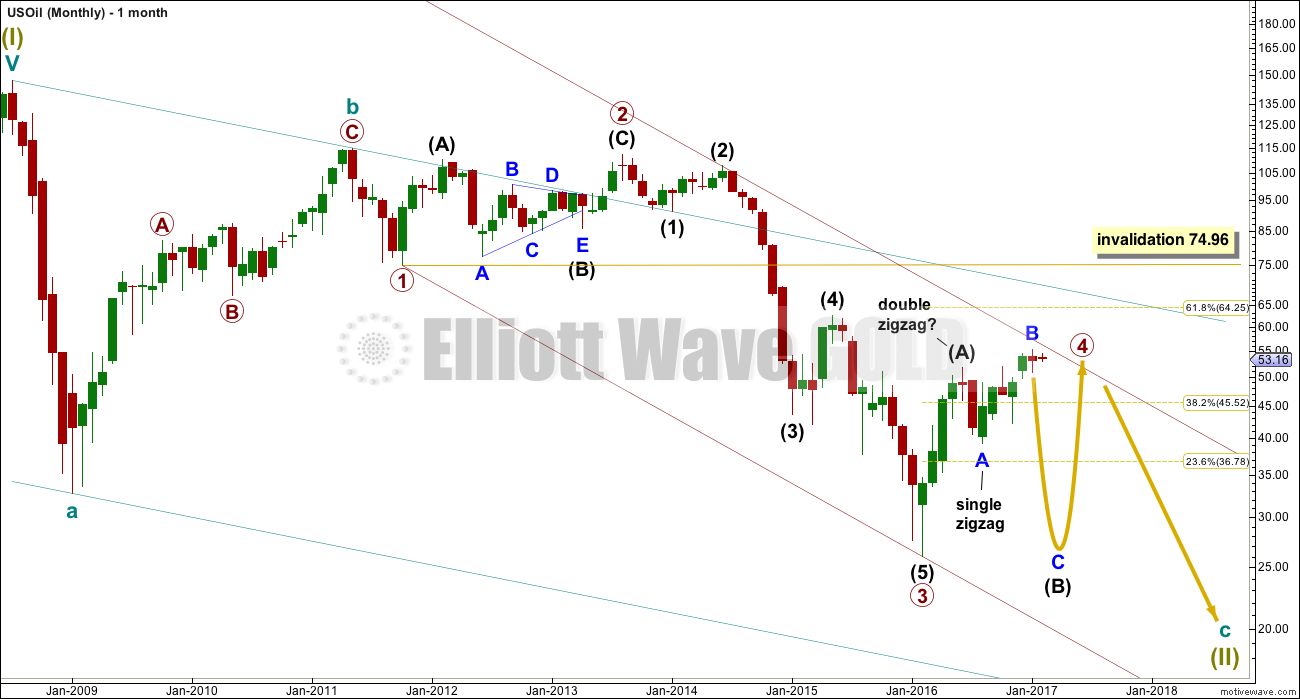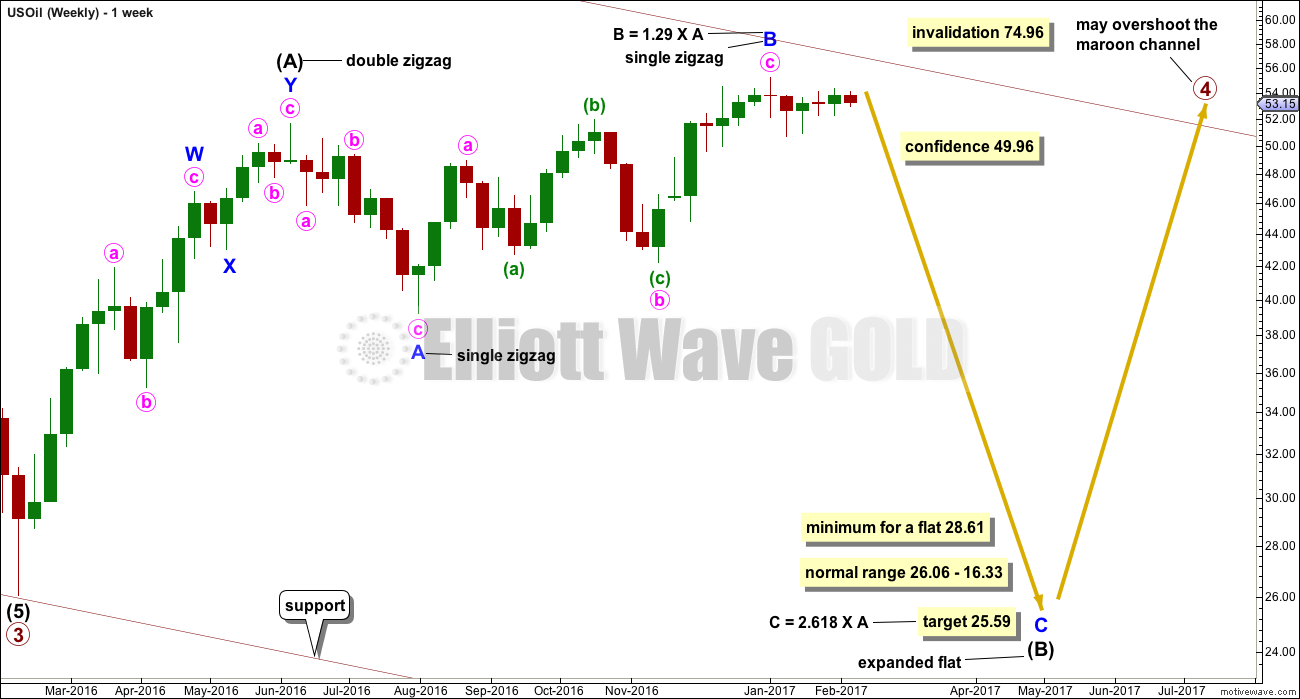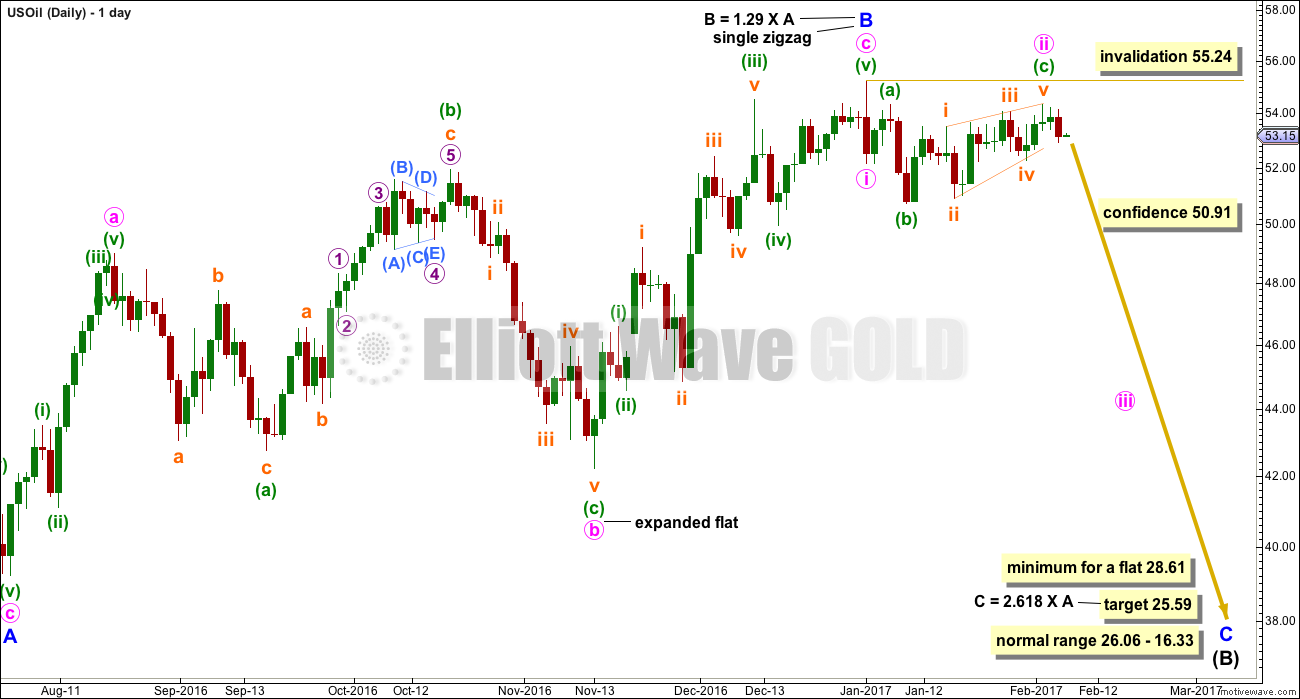Price continues to consolidate for US Oil. On Balance Volume may assist to show the breakout direction, so it should be watched carefully.
The Elliott wave counts remain the same.
Summary: A new high above 55.24 would indicate an upwards breakout, and the target would be 55.60. A new low below 50.91 would indicate a downwards breakout, and the target would be 28.61, minimum, with a next target possibly at 25.59.
New updates to this analysis are in bold.
MONTHLY ELLIOTT WAVE COUNT
Within the bear market, cycle wave b is seen as ending in May 2011. Thereafter, a five wave structure downwards for cycle wave c begins.
Primary wave 1 is a short impulse lasting five months. Primary wave 2 is a very deep 0.94 zigzag lasting 22 months. Primary wave 3 is a complete impulse with no Fibonacci ratio to primary wave 1. It lasted 30 months.
Primary wave 4 is likely to exhibit alternation with primary wave 2. Primary wave 4 is most likely to be a flat, combination or triangle. Within all of these types of structures, the first movement subdivides as a three. The least likely structure for primary wave 4 is a zigzag.
Primary wave 4 is likely to end within the price territory of the fourth wave of one lesser degree; intermediate wave (4) has its range from 42.03 to 62.58.
Primary wave 4 may end if price comes up to touch the upper edge of the maroon channel. The upper edge of this channel has been pushed up to sit on the end of intermediate wave (2) within primary wave 3.
Primary wave 4 is most likely to be shallow to exhibit alternation in depth with primary wave 2. So far it has passed the 0.382 Fibonacci ratio at 45.52. It may now continue to move mostly sideways in a large range.
Primary wave 4 may not move into primary wave 1 price territory above 74.96.
At this stage, primary wave 4 has completed intermediate wave (A) only. Intermediate wave (B) is incomplete.
WEEKLY ELLIOTT WAVE COUNT
The whole structure of primary wave 4 is seen here in more detail.
The first wave labelled intermediate wave (A) is seen as a double zigzag, which is classified as a three.
Intermediate wave (B) is also a three. This means primary wave 4 is most likely unfolding as a flat correction if my analysis of intermediate wave (A) is correct. Flats are very common structures.
Intermediate wave (B) began with a zigzag downwards. This indicates it too is unfolding most likely as a flat correction.
Within intermediate wave (B), the zigzag upwards for minor wave B is a 1.29 correction of minor wave A. This indicates intermediate wave (B) may be unfolding as an expanded flat, the most common type.
The normal range for intermediate wave (B) within a flat correction for primary wave 4 is from 1 to 1.38 the length of intermediate wave (A) giving a range from 26.06 to 16.33.
Primary wave 4 may not move into primary wave 1 price territory above 74.96.
Within the larger expanded flat correction of primary wave 4, intermediate wave (B) must retrace a minimum 0.9 length of intermediate wave (A) at 28.61 or below.
DAILY ELLIOTT WAVE COUNT
Minor wave B is seen in this main wave count as a complete single zigzag. The upwards wave labelled minute wave a is seen as a five wave impulse.
Minor wave C downwards should have begun. Within minor wave C, minute wave ii may not move beyond the start of minute wave i above 55.24.
Minor wave C downwards must subdivide as a five wave structure.
Minute wave ii may now be a complete expanded flat correction. Minuette wave (c) within it has moved slightly above the end of minuette wave (a), so a truncation and a very rare running flat is avoided. Minuette wave (c) is labelled as an ending contracting diagonal, the classic pattern equivalent is a rising wedge. These are terminal structures. The fifth wave ends at the i-iii trend line and there is no overshoot. An overshoot would have a better look, but it is not necessary as it is not a rule.
A new low below 50.91 would invalidate the alternate wave count below and provide some confidence in this main wave count.
ALTERNATE DAILY ELLIOTT WAVE COUNT
Minor wave B is seen as an incomplete double zigzag. The first wave up labelled minute wave w is seen as a zigzag. This is the main difference between the two wave counts.
Minute wave y must subdivide as a zigzag. Sideways movement over the last few weeks may be a triangle within it for minuette wave (b).
Minuette wave (c) would be very likely to make at least a slight new high above the end of minuette wave (a) at 54.50 to avoid a truncation.
The normal range for minor wave B within the larger flat correction of intermediate wave (B) is from 1 to 1.38 the length of minor wave A, giving a range from 51.67 to 56.41. The target calculated for minuette wave (c) to end would see price end within this range.
In the short term, within minuette wave (c), the correction for subminuette wave ii may not move beyond the start of subminuette wave i below 50.91.
TECHNICAL ANALYSIS
DAILY CHART

Click chart to enlarge. Chart courtesy of StockCharts.com.
Price continues to move sideways with declining volume. Price is bound by resistance about 54.50 and support about 50.35. During this sideways consolidation, it is an upwards day which has strongest volume suggesting an upwards breakout is more likely than downwards. This supports the alternate Elliott wave count.
ADX is flat and below 15 indicating the market is not currently trending; it is consolidating. The +DX line is above the -DX line. So if ADX reaches above 15 and shows an increase here, then an upwards trend would be indicated.
ATR is declining in agreement with ADX that Oil is consolidating.
On Balance Volume is bound by resistance and support. No breakout yet has occurred to indicate the next direction for price. The upper purple line for resistance is today adjusted.
RSI is hovering just above neutral. There is plenty of room for price to rise or fall.
Stochastics is returning from oversold.
A range bound approach to this market may now expect price to move higher and only end an upward swing when price finds resistance and Stochastics reaches overbought at the same time. At this stage, with price so close to resistance and Stochastics so close to overbought, an end to this upwards swing should be expected very soon. Then it may be followed by a downwards swing.
Bollinger Bands are tightly contracted. Volatility will return to this market. The longer Bollinger Bands remain contracted the more explosive the next movement may be.
This week’s classic technical analysis still slightly supports the alternate Elliott wave count over the main Elliott wave count. The situation is still mostly unclear for Oil this week.
Wait and watch for a breakout from the consolidation. Look for the breakout to have support from volume. Watch On Balance Volume very carefully because it may break just before price does. If that happens, OBV may indicate the breakout direction.
If entering a position after a breakout, remember to manage risk. Always use a stop and never invest more than 1-5% of equity on any one trade.
This analysis is published @ 09:57 p.m. EST.





Lara,
I wanted to ask and see if you see any possibility of an alternate bullish wave count for oil?
What would be the chance that primary wave 5 ended at the last lows and now we’re on the way up?
Much appreciated…
Hi, anyone got a count for oil?
Looks like Lara’s alternate is in play.
There is so much bullishness in the news. All the dips being bought, and the peaks being sold when inventory reports come out weekly. But even with last week’s huge inventory build, price couldn’t go below Lara’s confidence point of 50.90…
Hi Lara!
Eleventh candle series up. H4
Is too much.
I think that the price will rebound from the line of dynamic resistance.
What do you think, Lara?
Thanks much for t’he very timely oil anàlysis Lara. Fits my energy thesis to a T! 😉
Excellent! And you’re most welcome as always Verne